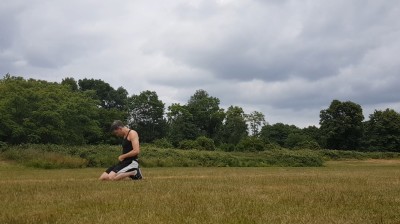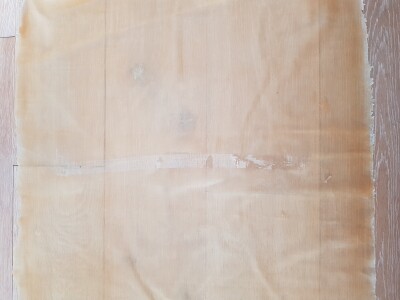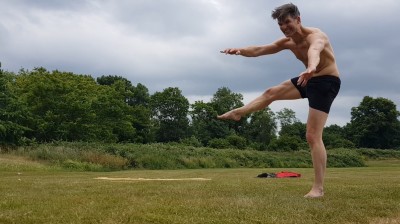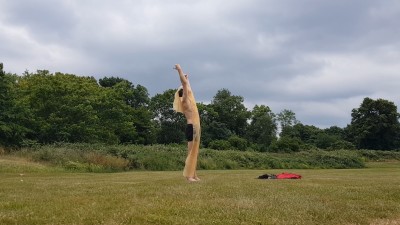Along with many other dance activities, the planned 2020 Modes of Capture Symposium was an online experience this year. The Symposium grew out of a creative partnership between Liz Roche Company and The Irish World Academy of Music and Dance at UL, and was presented as part of the Dublin Dance Festival‘s Digital Capsule. This year’s theme was an exploration of
how dance artists exchange knowledge and experiences across extended networks and through multiple generations that span distance and time. It asks how we might reimagine ways of artistic exchange and how we think about legacy and connection in light of current social and environmental realities.
At a time when I was doing a lot of strategic thinking for others, I was really nourished by Liz’s invitation to me as an artist to record a talk for the symposium. The idea of artists’ exchange and connection had been already on my mind as I thought about how to resource myself creatively in lockdown. I’d started to think about Cure, a solo I performed made through the support of others, and so I used the symposium as an opportunity to think about what interdependence and connection might mean in a time of enforced physical isolation.
Here’s the video I recorded and below a partial transcript of what I wrote:
Last month I took part in Sous Influence, an online version of a participatory choreography and format created by Éric Minh Cuong Castaing. It’s a guided immersion into a kind of clubby trans-generational trance dance of togetherness , that I think Eric is brilliant at creating through his considered generous work, and though we were joining via Zoom, I enjoyed the sweaty freedom of it even if it was in my own spare room, where I’ve taken down the lampshade from the ceiling to stop my arms bashing into it. At the end of the session, in a cool down phase, Éric asked us to sense in our bodies all of the bodies that had touched us and I found myself emotional at the thought.
I realised that in this moment of physical isolation, that I am drawing heavily on all of the traces of others moving that make my body. The movement patterns, choices, habits, knowledge of others that I’ve seen, that I’ve touched, that I’ve danced with have informed my capacities. I move and recognise others in my movement and I smile, enriched but also a little sad that I don’t know how I will reinforce or top up those influences. Because to say that our bodies are made through others is not to adopt a wholly social constructionist account where bodies are blank pages to be written on by bigger forces that deny us agency and remove the responsibility for ethical choice. I am made through others but I have made choices about which others I open myself to, invite into influence. And in that ongoing process of making and performing my corporeal self, I have agency which is not the same as control. Instead I think of it as a skilled improvisation where the roles of leading and responding are shifting between the movers and perhaps with a speed, clarity and sensitivity that make it impossible to tell what is leading and who is following.
In contrast to an ideology which I’m afraid I’ve accepted and reinforced for much of my career, I am not independent, not an independent artist, not an independent body. In her book, Artist at Work, Bojana Kunst shows how the artist and particularly the mobile dance artist has become the model worker of the neoliberal economy – creative, flexible, communicative, ‘incessantly active in all its possible forms and in the realisation of its potentiality’ (p.139). Against that exhausting and isolating vision of independence I want to acknowledge our corporeal interdependence, which offers me a different kind of ethics with which to imagine how I might respond to the world in which we find ourselves at the moment.
To explain a little of how I understand all of this:
I want to share a project called Cure that I premiered in the Dublin Dance Festival in 2013. Cure was a piece I set about making to figure out what it takes to recover. It seems like it’s research that I need to renew now. Like now, The idea of recovery was very much in the public domain in 2011-2012, as Ireland was still trying to make its way back from economic collapse, from a loss of faith in political and religious authorities and perhaps from a loss of faith in ourselves as citizens who had somehow been complicit in all that had gone wrong. Recovery also had a very particular personal physical resonance for me, as I was returning to dancing having had knee surgery to repair a torn meniscus, a tear that finally manifested itself when I was dancing on the concrete floors of the Ireland Pavilion in the Shanghai Expo in 2010. My body couldn’t keep performing for the nation’s attempt to attract global investment in conditions that wouldn’t support it properly. It declared a vulnerability that demanded care. Geographer and philosopher Paul Harrison argues that ‘Vulnerability… describes the inherent and continuous susceptibility of corporeal life to the unchosen and the unforeseen – its inherent openness to what exceeds its abilities to contain and absorb.’ (‘Corporeal Remains: Vulnerability, Proximity and Living On After the End of the World’, Environment and Planning A: Economy and Space, 40, 2, pp. 423-445, p. 427). Instead of thinking of bodies as endlessly active and capable, recognizing their fraility, fragility, tiredness, illness opens up the possibility of connecting to others, of acknowledging my reliance on them.
Ostensibly, Cure was a solo for me but to make it I commissioned the five dancers and visual artist who had been involved the previous work I’d made called Tabernacle. Mikel Aristegui, Bernadette Iglich, Matthew Morris, Elena Giannotti and Stéphane Hisler were the dancers and Sarah Browne, the visual artist. I asked each of them to make a ten minute solo for me on the idea of Cure and I assembled those solos into a single piece. I’d known all of the dancers for a long time, having created, rehearsed and performed alongside, on top of, underneath them (except of Elena with whom I worked for the first time on Tabernacle but whom I’d seen perform often in the work of Michael Klein for Daghdha and for Rosemary Butcher). They had created with me and carried my choreography over the years, and what I call ‘my’ choreography took form through their thinking, feeling and moving. With Cure I wanted to more clearly acknowledge their creative agency and my dependence on them, to shift the traditional power relationship of choreographer and performer (though the reality of collaboration in the studio counters that dynamic, the structures of financial reward and professional advancement still usually favour the one who gets called choreographer). And I wanted to put my own body in play – not the god-like absence invisibly directing action from outside, but a vulnerable visibility available to act. I’d like to think that the dancers always felt that more collaborative and equal power relationship in our work but with Cure – and the communication around it, I wanted to make it more visible to others outside the process and make that visibility part of the overall curation and choreography of the project. This shift away from old structures also felt right because this recovery wouldn’t be about going back. My knee would not be the same as before surgery. So, moving on demanded that things be done differently.
In practice, for the process of creation, instead of gathering to me all the choreographers (as would have happened if I’d been choreographer), I travelled to where they were – to Australia for Stéphane, to Berlin where Mikel was based, to London with Matthew and Bernadette, to Dublin with Elena and to Limerick with Sarah. Our working processes would have suited an era of social distancing since there were usually just two of us in ample studios with minimal physical contact in the creative process. The material was generated through my responses to their instructions and stimuli. I think all of the movement material came from me and yet, responding to their ideas, shaped by the atmospheres of their creative processes, and knowing them through years of seeing them, I carried something of each of them into the work too. Even Sarah, whom I didn’t know as a dancer, I knew as a dedicated long-distance swimmer. And something of her physical practice informed how I responded to her choreographic input that was mostly communicated through the latex material she introduced into the creation.
I look back on Cure, on the care (the Latin root of cure – curare means to take care) the choreographers took of me and on the challenges they set me, and think that I have never felt more at home in performance than in that piece.
‘[C]are’ Karen Till tells us, ‘challenges the Western Enlightenment assumption that individuals are autonomous and self-supporting, forcing us to recognise that not all humans are treated equally in society.’ (Karen E. Till, ‘Wounded Cities: Memory Work and a Place-based Ethics of Care’ Political Geography 31 (1),pp. 3-14, p. 12; ). Taking care and allowing oneself to be cared for acknowledges and enacts interdependence. I experience this care from each of the choreographers but also from the whole creative team. After the initial phases of creation with each choreographers, I assembled the work in the studio in Dancehouse with Mags Corscadden as Stage manager as a constant presence to witness my otherwise solo rehearsals. And Alma Kelliher as composer and Ciaran O’Melia as designer became regular allies in the rehearsal room too, offering the support of accompaniment, that of their design and creative skills but also their presence. And we tried to offer some of that experience of care to people beyond the creative team too. Just before premiere at the Dublin Dance Festival, we held a supper on the idea of Cure with Create, Dublin Dance Festival and FireStation, making food for a group of people who signed up to share their own experience of recovery in beautifully philosophical and personal ways. Sharing insights that could resource me in my performance on the work. I recall the Create and DDF teams helping to make and prepare that food and I’m especially grateful to them for recognizing how this work was already part of the choreography we were making. We continued this practice of sharing food and discussion when we toured the work around Ireland, and this process of sharing not only the work but some shared conviviality helped assert that performing the work wasn’t just a commercial transaction between audience and performer but a work of shared reflection and experience, with care activated in both directions.
I’m reminded of the Irish phrase trín’a chéile – it means upset or in disarray and often has a negative meaning because of that. It literally means through one another, and for me there is a positive potential in this through otherness. Because the disarray and upset of the usual allows for a new array, for a change of old habits, old patterns. It is the surprise of otherness that makes new things possible and maybe new things better. The risk of never being in disarray is that nothing ever changes and everything remains the same.
So, in thinking about what it takes to recover, which is never really a going back to what has been, but a moving on from where we are, the surprise of otherness is helpful.
 One of the things I’ve realised in lockdown is that, for the most part, I’ve separated my creative work from my domestic life. Our home is a haven where I may do admin, squeeze a dance class into the space available and roll out a yoga mat, but it’s not really the place for making work. So I’ve done my DownDog yoga, my Cunningham classes online with the teachers in New York and my Freeletics fitness training during lockdown, but I haven’t found it so easy to connect to a sustaining creative impulse. I think it’s been deliberate that I’ve maintained a separation between home and that work over the years and I’m very mindful of how the imperative to connect online has forced many people to share their private spaces for work – whether it’s in lockdown performances or professional meetings.
One of the things I’ve realised in lockdown is that, for the most part, I’ve separated my creative work from my domestic life. Our home is a haven where I may do admin, squeeze a dance class into the space available and roll out a yoga mat, but it’s not really the place for making work. So I’ve done my DownDog yoga, my Cunningham classes online with the teachers in New York and my Freeletics fitness training during lockdown, but I haven’t found it so easy to connect to a sustaining creative impulse. I think it’s been deliberate that I’ve maintained a separation between home and that work over the years and I’m very mindful of how the imperative to connect online has forced many people to share their private spaces for work – whether it’s in lockdown performances or professional meetings.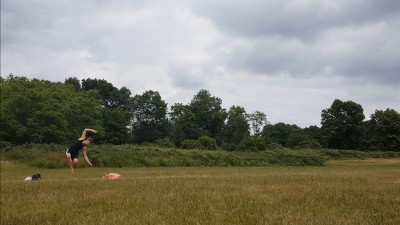 Talking to Sarah by Skype, it was interesting to think about what this rubber sculpture communicated in the era of PPE. We’d thought about HIV and the protective barrier of latex in intimacy already when we were making Cure. In addition to those abiding health and medical resonances, Sarah’s recent work on fitness and bodily training, Public feeling, came to the fore as I connected my work on Latex (2020) to the fitness training I’ve been doing in lockdown – an AI-mediated fitness app called Freeletics – and to the many others doing their fitness training around me on the cricket pitch near my home where I ended up filming the performance. I filmed different versions over a couple of weeks, figuring out what to wear, what framing seemed right, what different weather conditions communicated. The version we chose for the performance in Dancer from the Dance is filmed on a sunny day with a lot of bird song and planes flying overhead. It’s Walthamstow in East London so not the rural Ireland I’ve seen in some of the work commissioned for the Modes of Capture symposium. I was a little envious of the space and privacy rural living might afford those performances and was very aware on this cricket pitch in London that I was claiming public space for my less usual activity. Part of the work of the performance was making that claim, mustering the courage to be visibly performing my physicality where others were doing theirs.
Talking to Sarah by Skype, it was interesting to think about what this rubber sculpture communicated in the era of PPE. We’d thought about HIV and the protective barrier of latex in intimacy already when we were making Cure. In addition to those abiding health and medical resonances, Sarah’s recent work on fitness and bodily training, Public feeling, came to the fore as I connected my work on Latex (2020) to the fitness training I’ve been doing in lockdown – an AI-mediated fitness app called Freeletics – and to the many others doing their fitness training around me on the cricket pitch near my home where I ended up filming the performance. I filmed different versions over a couple of weeks, figuring out what to wear, what framing seemed right, what different weather conditions communicated. The version we chose for the performance in Dancer from the Dance is filmed on a sunny day with a lot of bird song and planes flying overhead. It’s Walthamstow in East London so not the rural Ireland I’ve seen in some of the work commissioned for the Modes of Capture symposium. I was a little envious of the space and privacy rural living might afford those performances and was very aware on this cricket pitch in London that I was claiming public space for my less usual activity. Part of the work of the performance was making that claim, mustering the courage to be visibly performing my physicality where others were doing theirs.
